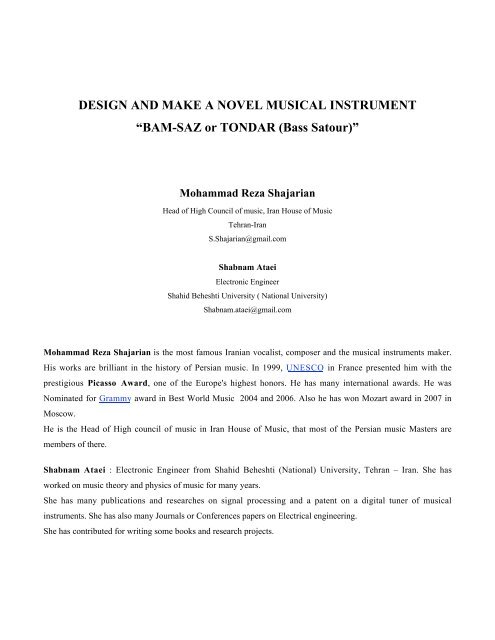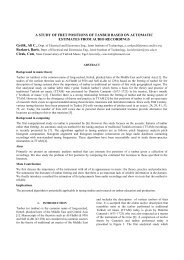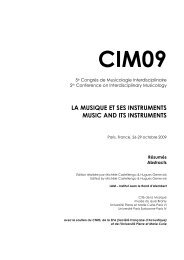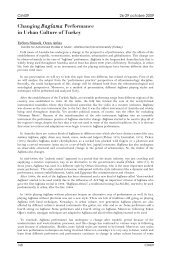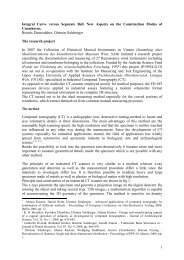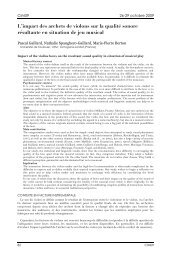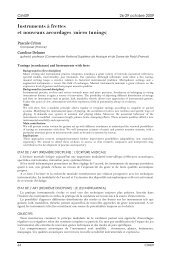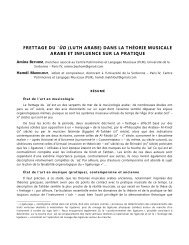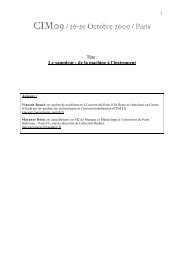DESIGN AND MAKE A NOVEL MUSICAL INSTRUMENT âBAM-SAZ ...
DESIGN AND MAKE A NOVEL MUSICAL INSTRUMENT âBAM-SAZ ...
DESIGN AND MAKE A NOVEL MUSICAL INSTRUMENT âBAM-SAZ ...
You also want an ePaper? Increase the reach of your titles
YUMPU automatically turns print PDFs into web optimized ePapers that Google loves.
<strong>DESIGN</strong> <strong>AND</strong> <strong>MAKE</strong> A <strong>NOVEL</strong> <strong>MUSICAL</strong> <strong>INSTRUMENT</strong><br />
“BAM-<strong>SAZ</strong> or TONDAR (Bass Satour)”<br />
Mohammad Reza Shajarian<br />
Head of High Council of music, Iran House of Music<br />
Tehran-Iran<br />
S.Shajarian@gmail.com<br />
Shabnam Ataei<br />
Electronic Engineer<br />
Shahid Beheshti University ( National University)<br />
Shabnam.ataei@gmail.com<br />
Mohammad Reza Shajarian is the most famous Iranian vocalist, composer and the musical instruments maker.<br />
His works are brilliant in the history of Persian music. In 1999, UNESCO in France presented him with the<br />
prestigious Picasso Award, one of the Europe's highest honors. He has many international awards. He was<br />
Nominated for Grammy award in Best World Music 2004 and 2006. Also he has won Mozart award in 2007 in<br />
Moscow.<br />
He is the Head of High council of music in Iran House of Music, that most of the Persian music Masters are<br />
members of there.<br />
Shabnam Ataei : Electronic Engineer from Shahid Beheshti (National) University, Tehran – Iran. She has<br />
worked on music theory and physics of music for many years.<br />
She has many publications and researches on signal processing and a patent on a digital tuner of musical<br />
instruments. She has also many Journals or Conferences papers on Electrical engineering.<br />
She has contributed for writing some books and research projects.
Abstract<br />
The issue of gaining the most harmonious sound from a musical instrument has always been a concern for Musical Maestros<br />
and Musical instrument makers. “ Since 1960 I have been preoccupied with enhancing the harmony of some of iranian<br />
musical instruments and in particular Santoor.” Said Mohammad Reza Shajarian, renowned Iranian Maestro and the author of<br />
this paper. The opinions regarding the aspect of Harmony, however, tends to be diverse. The fact that has resulted in various<br />
designs and Makings of Musical Instruments. This paper specifically aims at analyzing one of the Iranian Musical<br />
instruments called the Santoor and introduces a newly-made instrument, Tondar, which is designed to produce a sound of a<br />
better quality in addition to enhancing the sound capacity of the Santoor.<br />
Introduction<br />
An outline of the concept of harmony in Musical<br />
Instruments<br />
In order to understand why certain combinations of notes<br />
make harmony and others don’t, we will study the simplest<br />
instrument, a single string. The formula for the frequency<br />
of a vibrating string is:<br />
1 ⎛<br />
f = ⎜<br />
2l<br />
⎝<br />
T<br />
D<br />
Frequency=(1/2*length)(tension/line density)^0.5<br />
When:<br />
Frequency is in Hertz=1/sec<br />
Length is in meters<br />
Tension is a force in Newton=kg*m/sec^2<br />
Line density is the string thickness, in kg/m<br />
⎞<br />
⎟<br />
⎠<br />
(1)<br />
Bam-Saz (Bass Santour Or “Tondar”): The Design and<br />
structure<br />
This fact has many physical manifestations in Musical<br />
Instruments design, such as:<br />
_ Low-sound instruments must be much larger than highsound<br />
ones. In general, an instrument which is an octave<br />
lower must be twice as large. For example, in the stringed<br />
instruments, a simple comparison yields the obvious fact<br />
that Contrabass is larger than cello and the others are viola<br />
and violin respectively.<br />
_ Lower Sounds are also to be produced through<br />
thickening the string or winding metal or fishing-nylon<br />
strings around it.<br />
In the next chapter, the design of the Santoor and the<br />
introduction of Tondar is further discussed<br />
Regarding the above-mentioned facts.<br />
Bam-Saz (Bass Santour)<br />
Persian musical instruments cover about 3-4 octaves in a<br />
moment with a specific tune. Besides, low frequencies and<br />
bass notes cannot be fully produced by the available<br />
instruments. Santoor is a Persian musical instrument that<br />
covers about 3 octaves. However, it cannot provide the<br />
ideal homogeneity which a Musician desires and the<br />
produced sound is not sharp enough, Therefore a need for<br />
an instrument with a much lower frequency coverage is<br />
observed.<br />
“BAM-<strong>SAZ</strong>” introduced in this paper is designed and<br />
made through a novel method of designing and measuring
of resonating strings including new measurements and<br />
designing method in addition to new braces sizes. It covers<br />
about 4.5 octaves, from A2 to G6 which grants us a choice<br />
of low frequencies that were unique among all of its<br />
Persian precursors.<br />
We, hereby, shed light on the techniques used for devising<br />
this instrument:<br />
The Modification of strings<br />
As we have already stated for strings measurements we use<br />
this formula:<br />
Frequency=(1/2*length)(tension/line density)^0.5<br />
350.0<br />
300.0<br />
250.0<br />
200.0<br />
f<br />
150.0<br />
D<br />
l<br />
100.0<br />
50.0<br />
0.0<br />
0 5 10 15 20 25<br />
G6 G4<br />
G3 G5<br />
F6 F4<br />
F3 F5<br />
E6 E4<br />
E3 E5<br />
D6 D4<br />
D3 D5<br />
C6 C4<br />
C3 C5<br />
B6 B4<br />
B3 B5<br />
A6 A3<br />
A3 A5<br />
G5 G3<br />
G2 G4<br />
F5 F3<br />
f<br />
F2 F4<br />
D E5 E3<br />
l<br />
E2 E4<br />
D5 D3<br />
D2 D4<br />
C5 C3<br />
C2 C4<br />
15 20 25<br />
B5 B3<br />
B2 B4<br />
G6<br />
F6<br />
E6<br />
D6<br />
C6<br />
B6<br />
A6<br />
G5<br />
F5<br />
E5<br />
D5<br />
C5<br />
B5<br />
Because of the bass sounds and long length of strings it can<br />
be used with damper.<br />
The classic Santoor and the Tondar can be compared in<br />
Figure No.2.<br />
G4<br />
G3 G5<br />
F4<br />
F3 F5<br />
E4<br />
E3 E5<br />
D4<br />
D3 D5<br />
C4<br />
C3 C5<br />
B4<br />
B3 B5<br />
A3<br />
A3 A5<br />
G3<br />
G2 G4<br />
F3<br />
F2 F4<br />
E3<br />
E2 E4<br />
D3<br />
D2 D4<br />
C3<br />
C2 C4<br />
B3<br />
B2 B4<br />
Fig.2 Iranian santoor compare with “Tondar”<br />
The Design of the body<br />
The classic santoor cannot produce an absolutely<br />
harmonious sound since due to its trapezoidal geometry the<br />
distance from the bridges to rails varies. Therefore the<br />
pressure applied on soundboard will be different because<br />
of the difference in Normal coordinate of the tensile Force.<br />
The solution offered in the design of the Tondar is to<br />
harmonize this coordinate through applying height to the<br />
ribs. (Fig. 3)<br />
The strings diameter sizes are between .035 and .070 and<br />
all of them are steel and without wounding and wrapping<br />
on the left hand and the right side strings diameters are<br />
between .24 and .070 with wrapping cover.
In addition, a modification has also been applied to the<br />
previous inner braces in order to reach the optimum<br />
efficiency in harmonizing sound by balancing the pressure<br />
on Soundboard and also preventing the redundant<br />
harmonics through dividing the inner space of sound box.<br />
(Fig. 4)<br />
Conclusion<br />
Fig. 2D & 3D figure of Bam Saz<br />
References<br />
1- Mathematical Harmonies, Mark Petersen, 2001.<br />
2- Johnston, Ian, Measured Tones, The interplay of<br />
physics and music, Hilger, NY, 1989.<br />
3- Pierce, John R., the Science of Musical Sound,<br />
Scientific American Library, NY, 1983.<br />
The figures below provide the wave forms and frequencies<br />
of the same note produced by classic Santoor and the<br />
Tondar.<br />
The frequencies are the same because the notes are the<br />
same. A note has one frequency and a frequency as a<br />
number is relate to one note.<br />
Waveforms of two notes (sol), 97 and 196 Hz Santoor &<br />
Tondar are shown in figures below


